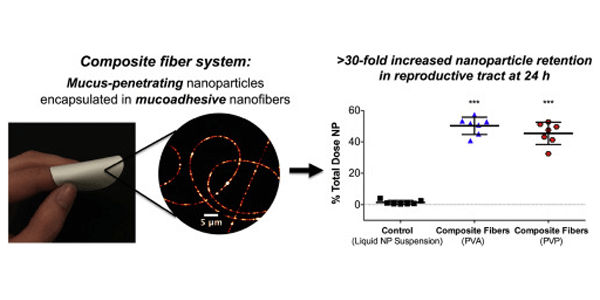Image: A composite fiber system of mucus-penetrating nanoparticles encapsulated in mucoadhesive nanofibers. The system demonstrated 30-fold increased nanoparticle retention in reproductive tract at 24 hr.
Nanoparticle-releasing nanofiber composites for enhanced in vivo vaginal retention
Emily A. Krogstad, Renuka Ramanathan, Christina Nhan, John C. Kraft, Anna K. Blakney, Shijie Cao, Rodney J.Y. Ho, Kim A. Woodrow
Biomaterials. Volume 144, November 2017, Pages 1-16.
Abstract
Current approaches for topical vaginal administration of nanoparticles result in poor retention and extensive leakage. To overcome these challenges, we developed a nanoparticle-releasing nanofiber delivery platform and evaluated its ability to improve nanoparticle retention in a murine model. We individually tailored two components of this drug delivery system for optimal interaction with mucus, designing (1) mucoadhesive fibers for better retention in the vaginal tract, and (2) PEGylated nanoparticles that diffuse quickly through mucus. We hypothesized that this novel dual-functioning (mucoadhesive/mucus–penetrating) composite material would provide enhanced retention of nanoparticles in the vaginal mucosa. Equivalent doses of fluorescent nanoparticles were vaginally administered to mice in either water (aqueous suspension) or fiber composites, and fluorescent content was quantified in cervicovaginal mucus and vaginal tissue at time points from 24 h to 7d. We also fabricated composite fibers containing etravirine-loaded nanoparticles and evaluated the pharmacokinetics over 7d. We found that our composite materials provided approximately 30-fold greater retention of nanoparticles in the reproductive tract at 24 h compared to aqueous suspensions. Compared to nanoparticles in aqueous suspension, the nanoparticles in fiber composites exhibited sustained and higher etravirine concentrations after 24 h and up to 7d, demonstrating the capabilities of this new delivery platform to sustain nanoparticle release out to 3d and drug retention out to one week after a single administration. This is the first report of nanoparticle-releasing fibers for vaginal drug delivery, as well as the first study of a single delivery system that combines two components uniquely engineered for complementary interactions with mucus.


